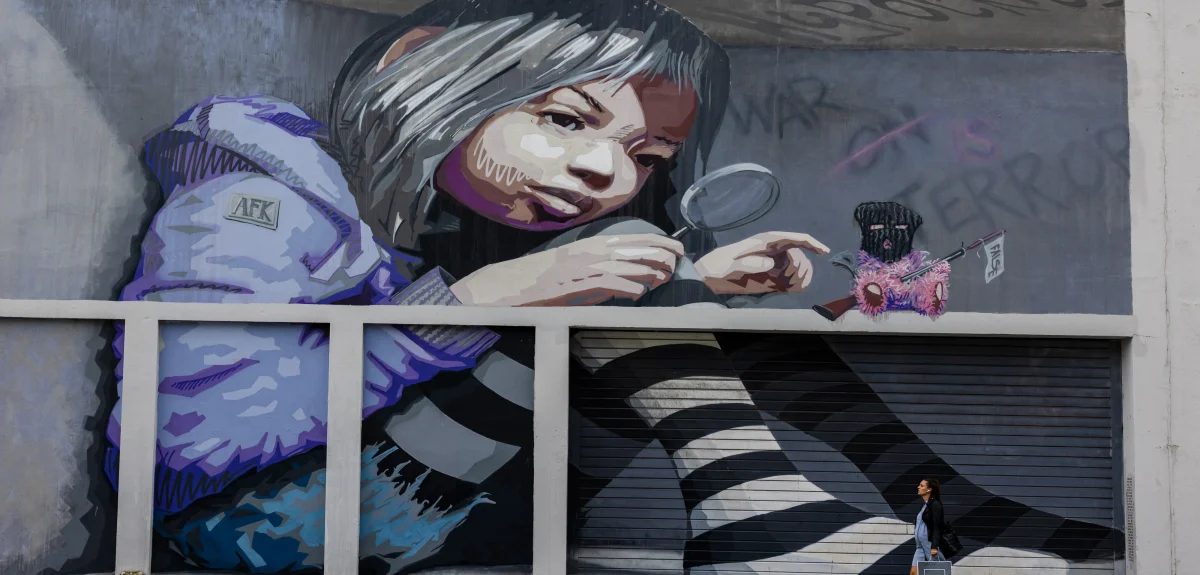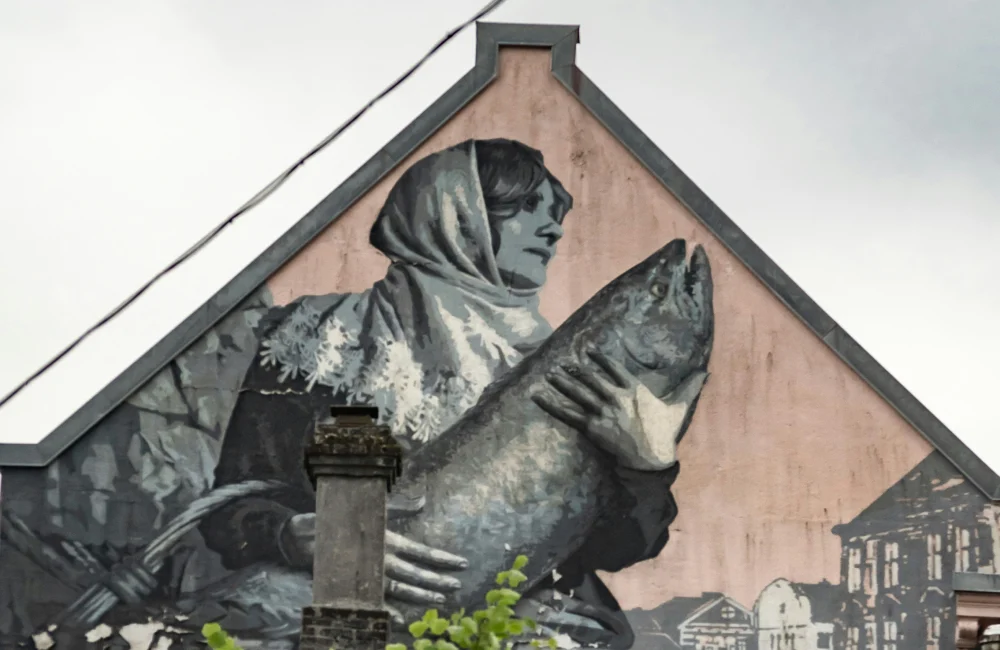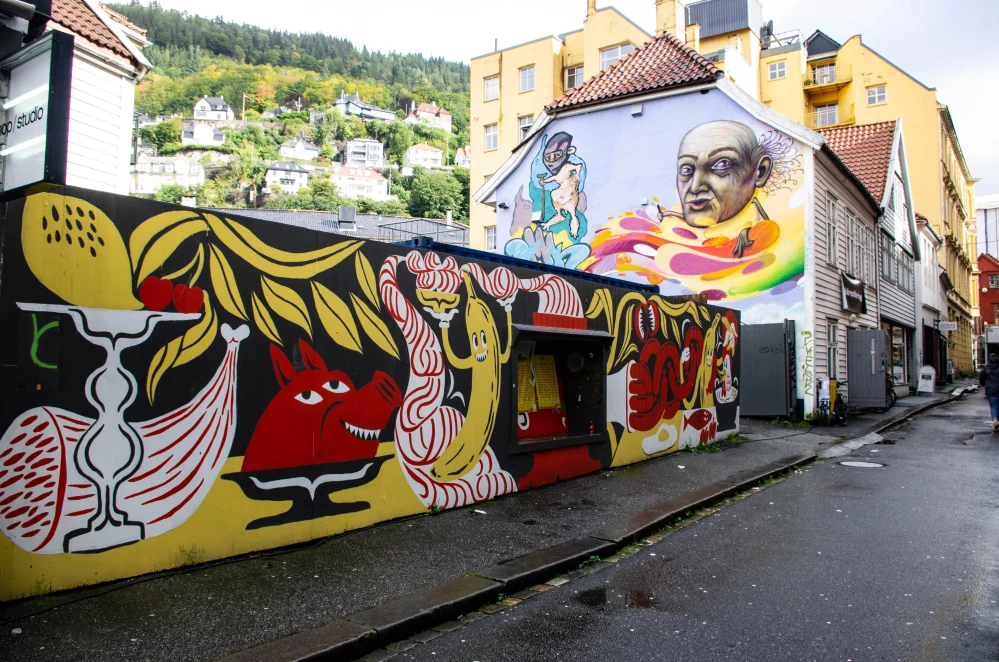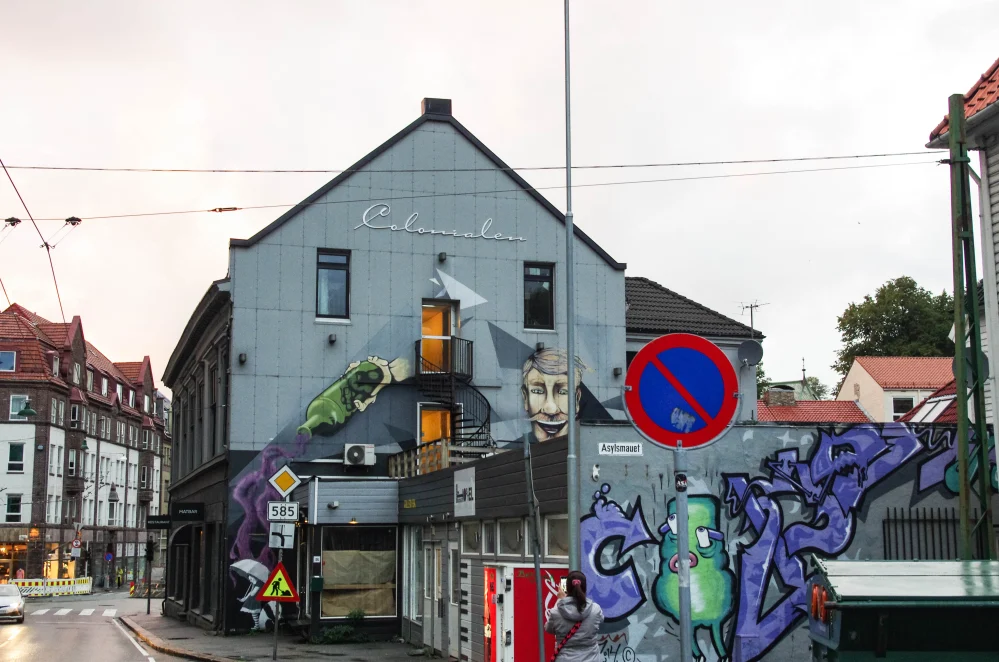
How Street Art has changed Bergen
Bergen is starting to get a reputation for its vivid street art.
Over the past 15 years the city’s facades have been given a raw and poetic facelift. Everywhere from Danmarks plass to Skostredet, the walls and corners have been adorned with paintings created using spray paints, brushes, and stencils. There is literally more to see in Bergen now.
“Street art has become Bergen’s signature,” says Petter Nord.
He is the manager of the artists’ collective called Bart, which brings together around 20 of Bergen’s street artists in an environment that helps to make Bergen a more colorful place.
“We bring color to the city. Which is just what we need in Bergen as its sits under gray skies. We have brightened up kindergartens, shopping centers, and offices.”

Visual satire
And Bergen’s walls talk to people. The artists interpret and comment on the world around them, using satire and asking questions. One of the artists is AFK, who has decorated several streets with his sharp visual commentary. Skostredet is home to the artwork called ‘Laugh’ which shows two old men, one Jewish and one Muslim, laughing heartily at Charlie Hebdo.
“I base my art on current affairs, inspired by news photos. ‘Laugh’ is a good example, where I have tried to create an inclusive interpretation of the Hebdo affair,” writes the artist AFK in an e-mail to Scandinaviantraveler.com.
AFK stands for Away From Keyboard. He wants to remain anonymous in order to avoid legal problems. Many of his murals are about how people are plundering nature at the expense of animals. One of the paintings shows a mournful panda receiving a text message from a girl. It could say “Sorry, but the world isn’t big enough for the both of us.”
But isn’t this raw art destroying the Bergen idyll? Bart’s Petter Nord thinks not.
“Street artists have great respect for the facades. No one touches listed walls or the funicular railway. The artists would rather go out into their surroundings and find walls where their work can help to increase the enjoyment of the area. It’s like a sculpture being brought into the area, giving the street an identity.”
And street art is coming in from the cold. Street artists, who traditionally work at night, are being accepted as artists and they now have their own walls to practice on. Bergen municipality also allocates money to street art projects.
“This is an art form we have cultivated in Bergen. Why this has happened in Bergen is hard to say. It could have something to do with the fact that we used to be an international trading center, while at the same time sitting in seclusion on the other side of the mountain to Oslo. As a result, we have cultivated things more, as we saw with the Bergen Wave in music.”

Banksy
Another important reason why Bergen has become the street art capital of Norway is that the now internationally acclaimed – and anonymous – contemporary artist Banksy came to Bergen in 2000. Marcus Smith Hvidsten was opening a nightclub in Bergen and wanted to decorate it. He had seen some Banksy graffiti in London so he invited Banksy, who at the time was completely unknown, to come to Bergen. There he created eight pieces for Hvidsten and his friends. But he also left behind several other traces of his work. Bergen municipality washed away the signed works – at that time no one could have known that fifteen years later Banksy’s work would be sold for half a million pounds at Sotheby’s auctioneers in London. Hvidsten himself sold one of the old chipboards a few years ago for a tidy sum.
“I called Banksy and asked if it was OK. He said I could do whatever I wanted. He was pleased to have been invited to Norway early in his career,” said Hvidsten in an interview with TV 2.
Hvidsten used the money to open the LOT 333 store, named after the auction number of the first Banksy work he sold.
Sign of the times
Graffiti comes from the Italian word graffire, which means to scratch. In ancient times it could be seen on the walls of Pompeii and in the catacombs of Rome, according to The Great Danish Encyclopedia. But graffiti of all kinds has been present throughout history, explains Petter Nord.
“Graffiti is a form of communication. Hobos traveling around the United States in search of food and work would scratch codes on fences and railings. These signs would tell others that jobs could be gotten here or to warn of an unfriendly dog. From the 1960s it was used by criminals to mark their territory. Later came the graffiti that is familiar today: overlapping text and images with lots of color, made using spray paints.”
Those who do it see graffiti, or street art, as an art form. There are several genres.
“There is graffiti with lettering and motifs. Then there is stencil art. These are motifs that have been cut out and are used as a template to spray the image onto the wall. This genre arose because it is has been illegal to spray on walls. Stencils allow street artists to paint a wall quickly.”
And AFK uses a number of techniques.
“In the beginning I often used scannable QR codes, where observers could get information and immerse themselves in the underlying idea. Today I am more concerned that the symbolism should appear in the subject itself. I try to make the symbolism more subtle, so that the observer has to work harder to understand the picture. The stencils I use are often more complex and I am more aware of the balance between aesthetics and message.”

Fine art
Through the Bart art collective, street art has made its way into the galleries.
“We wanted to bring the artists together. Cooperation makes for good business. Brush artists are going out into the street and we are mixing genres and techniques to see what might happen. Our motto is ‘Bart brings the street in out of the cold and takes fine art out into the rain’.”
Meanwhile, street artists have been drawn into the galleries.
“We have held several charity auctions and received NOK 800,000 for exclusive works by the street artists. They took motifs from the street that people had walked past and put them on canvas. People bid on everything.”
But it’s still about street art being created for the people – by the people.
“Our philosophy is that art should belong to all, not just the elite. What we create on canvas will be found on a wall for everyone to see.”
If you are heading to Bergen, you should keep your eyes peeled.
“One of the best places is Skostredet, which has become a melting pot for creative talents. But you could also easily walk past street art without even noticing it. If you discover a work of art, you should take note of the considered location and how the walls are talking to one another.”
Text by Inga Ragnhild Holst